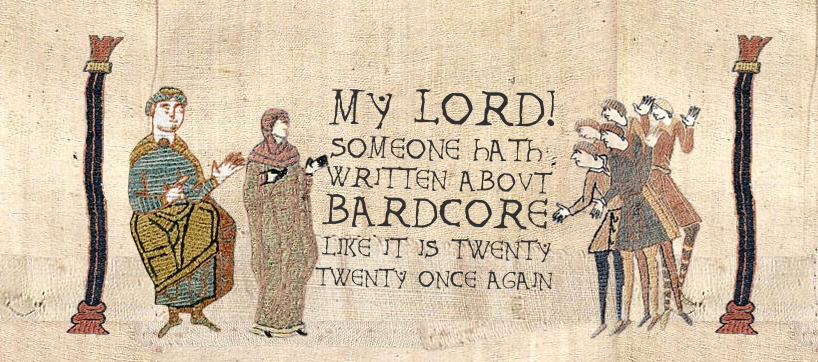
Posted by Edward Mills
17 February 2025Medieval music doesn’t typically occupy a prominent place on the Radio 1 Breakfast Show. Nevertheless, a couple of weeks ago saw an unexpected collision of the two, as a discussion of new acoustic music by Sam Fender (55:10 in the link) veered sideways into questions about what the artist’s ‘medieval’ name would be. During this chat, the term ‘bardcore’ popped up, causing me — who’s had the good fortune to teach courses on music and the Middle Ages — to prick up my ears. For the uninitiated, ‘bardcore’ refers to the practice of creating ‘medieval-style’ versions of modern pop songs, most commonly by replacing guitars with synthesised lutes and swapping vocals with woodwinds. In true Internet fashion, it emerged as a meme upon a meme, with the first ‘bardcore’ video appearing in early 2020 as a ‘tavern-style’ cover of the then-popular Dancing Pallbearers soundtrack. (If it took you as long to read that last sentence as it took me to write it, the ever-reliable Know Your Meme has a more succinct introduction.)
At the time, I remember thinking that someone, somewhere needed to write at least one journal article (possibly several) on the ‘bardcore’ phenomenon. Beyond a fairly cursory Guardian article, which framed it as a macabre response to the Covid pandemic, there was vanishingly little attempt to explain the then-new phenomenon. Happily, I’m pleased to report that someone has answered the call: Javier Arroyo Bretano has examined the genre as an example of what he terms ‘post-translated phenomena’ arising from a very specific social context.
The heyday of bardcore was definitely around 2022: many of its core proponents, including Beedle the Bardcore (itself a pun on a legendary figure in the Harry Potter series) and the to-the-point Medieval Bops, were at their most active in the wake of the Covid pandemic. And yet ‘bardcore’ has persisted, with a smaller-yet-vocal community based largely around YouTube. Perhaps its most ardent proponent is the appropriately-named Hildegard von Blingin’, whose YouTube channel recently passed 1 million subscribers.
Hildegard has distinguished herself from other practitioners by ‘medievalising’ not only instruments, but also the lyrics to the songs that they cover: witness the adaptations of the Rolling Stones’ Paint it Black (‘I see them maidens fair / Dressed in their summer clothes’) and Dolly Parton’s Jolene (‘Jolene / I beg of thee, pray take not my lord’). As Hildegard noted in an interview for ABC Classic in Australia, there’s a Pythonesque humour here, built partly on the incongruity between the bardcore productions and their cultural referents, but there may be more than simply comedy at work. ‘There’s a bit of comradery [between us and the Middle Ages],’ Hildegard commented. ‘People are saying that they feel the world is evolving backwards.’
Nowhere is this anxiety more evident than in one of their most recent works, We Didn’t Start the Fire. Its full title, We Didn’t Start The Fire (Bardcore ⏐ Medieval/Renaissance Style Cover), sets out its stall early, casting its net over a bewilderingly vast time period and collapsing the millennium between 500 and 1500 into a single, homogenised whole. References to Charlemagne sit alongside Anne Boleyn’s decapitation; ‘Timur in Afghanistan’ leads straight into the Princes in the Tower. The result, for the listener, is a form of historical whiplash, where any sense of chronology or connection is thrown to the winds. If ‘bardcore’ has made medieval music more accessible than ever, it has arguably turned medieval history into (to borrow a History Boys quote) ‘one damn thing after another’.
But perhaps I’m being too harsh here. After all, Hildegard and their collaborators aren’t trying to recreate a so-called ‘authentic’ Middle Ages, but instead are deploying various medieval tropes — thees, thous, and lutes, among others — as a sort of canvas on which they can make their own creations. Hildegard herself definitely knows this, as her aptly-titled My Most Historically Accurate Song Yet swiftly shows. ‘Bardcore’ is, at its heart, a creative enterprise, one that takes great pleasure in playing with popular perceptions of the past, and one which has a great deal to say about how we understand the Middle Ages.
Plus, if you hang around on bardcore YouTube for very long, you’ll eventually end up listening to The House of the Rising Sun in Old French. That’s got to be worth something.
(Deliberately low-quality) image created using the Historic Tale Construction Kit. Many thanks to the students on SML2209 who contributed to our discussions on ‘bardcore’ (Senara Addison, Emily Beers, Felicity Cotton, Charlotte Fawcett, Greta Gotke, Lily Griffiths, Tara Pittaway, Walter Rohrkasten, and Abbie Summerfield), and to Charley Sweet and Becca Pettitt for alerting me to the Greg James / bardcore connection. I’m also grateful to Nat Reeve for his unbridled enthusiasm for all things Hildegard von Blingin’.